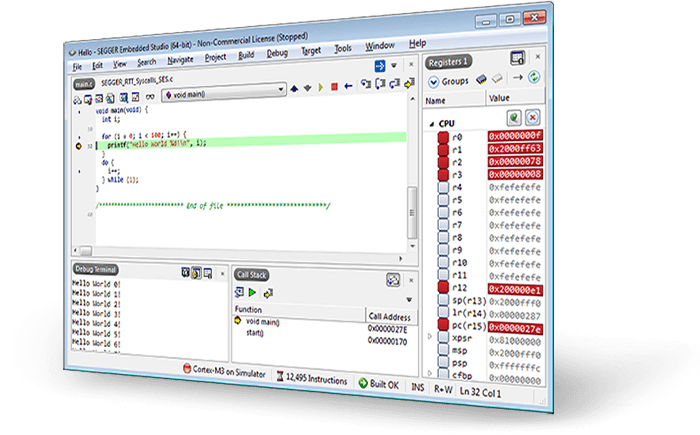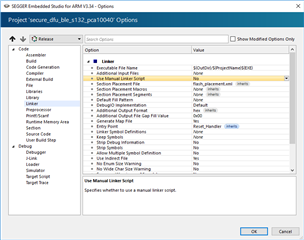
- SEGGER EMBEDDED STUDIO GCC LINKER SCRIPT HOW TO
- SEGGER EMBEDDED STUDIO GCC LINKER SCRIPT INSTALL
- SEGGER EMBEDDED STUDIO GCC LINKER SCRIPT CODE
- SEGGER EMBEDDED STUDIO GCC LINKER SCRIPT DOWNLOAD
The memory-map file and will list the sections to be placed in those Segments called FLASH and SRAM could look somethingĪ corresponding section-placement file will refer to the memory segments of To be shared across projects and also enables a project to be built for aįor example, a memory-map file representing a device with two memory Map from the section-placement scheme enables a single hardware description Program sections in the target's memory segments. The section-placement file specifies where to place Specifies the start address and size of target memory They can be edited with the SEGGER Embedded Studio for ARM text editor. These XML-formatted files areĭescribed in Memory Map file format and Section Placement file format. The SEGGER Embedded Studio for ARM project system uses memory-map files and To describe how the program sections of your program are positioned in memory,
SEGGER EMBEDDED STUDIO GCC LINKER SCRIPT CODE
There is often more than one code section and they must be There are program sections for code, initialized data, and zeroed data. If you would like to program the on-board FLASH memory using OpenOCD instead of the J-Link software, you can create a FLASH programming plugin similar to the one described in this tutorial.Executable programs consist of a number of sections. Then Go to the “Debug Settings” page, select “Debug Methods” instead of “USB Devices”, pick OpenOCD, choose CMSIS-DAP as the JTAG/SWD programmer and edit the OpenOCD command line to use the configuration file from the project directory: Now you will be able to debug your program using the on-board CMSIS-DAP interface.
SEGGER EMBEDDED STUDIO GCC LINKER SCRIPT DOWNLOAD

SEGGER EMBEDDED STUDIO GCC LINKER SCRIPT HOW TO
Now we will show how to use the on-board CMSIS-DAP interface instead of Segger J-Link.As the imported project includes all the necessary code from the SDK, you can use the CodeJumps popups to explore relations between different parts of the program itself and the i.MX RT SDK: You can use the regular debugging techniques to debug your program.Set a breakpoint near the GPIO_PortToggle() call and wait for it to trigger:.Verify that the on-board LED is blinking: Now you can build the project by pressing Ctrl-Shift-B:.Select “Segger J-Link” on the Debug Method page and click “Finish” to generate the project:.Connect J-Link to the 20-pin JTAG connector and plug both J-Link and the board into the USB ports: It comes with out-of-the-box support for on-board FLASH memory programming and is much faster than the on-board CMSIS-DAP interface. The easiest way to debug the i.MX RT devices would be using an external Segger J-Link device. The last page of the wizard allows configuring the debug interface.In this tutorial we will use use the “igpio_led_output” example: Click “KSDK Samples” to view the vendor-supplied samples instead. As the SDK was imported automatically, it won’t contain any VisualGDB-supplied example projects.VisualGDB will import the SDK and display the i.MX RT devices in the device list.


Open the MCUXpresso online SDK builder, select your board and click “Build MCUXpresso SDK”: Instead, you need to generate an SDK for your board online. The i.MX RT devices do not come with a regular stand-alone SDK.We will create a basic “Blinking LED” project for the IMXRT1050-EVB board and will show how to debug it using Segger J-Link and the on-board CMSIS-DAP-compatible interface.
SEGGER EMBEDDED STUDIO GCC LINKER SCRIPT INSTALL
Before you begin, install VisualGDB 5.4 Beta 2 or later. This tutorial shows how to create a basic project targeting the i.MX RT device using Visual Studio and VisualGDB.


 0 kommentar(er)
0 kommentar(er)
